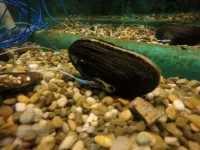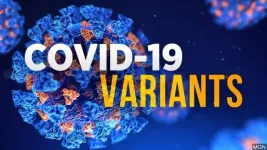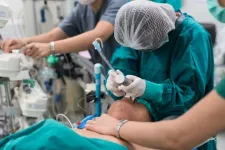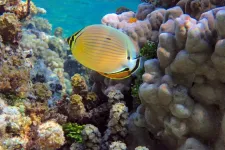(Press-News.org) Researchers at North Carolina State University have designed and demonstrated a new system that allows them to remotely monitor the behavior of freshwater mussels. The system could be used to alert researchers to the presence of toxic substances in aquatic ecosystems.
"When mussels feed, they open their shells; but if there's something noxious in the water, they may immediately close their shells, all at once," says Jay Levine, co-author of a paper on the work and a professor of epidemiology at NC State. "Folks have been trying to find ways to measure how widely mussels or oysters open their shells off and on since the 1950s, but there have been a wide variety of challenges. We needed something that allows the animals to move, can be placed in streams and collects data - and now we have it."
"We've basically designed a custom Fitbit to track the activities of mussels," says Alper Bozkurt, corresponding author of the paper and a professor of electrical and computer engineering at NC State.
The fundamental idea for the research stems from the fact that feeding behavior in mussels is generally asynchronous - it's not a coordinated affair. So, if a bunch of mussels close their shells at once, that's likely a warning there's something harmful in the water.
One of the things the researchers are already doing with the new sensor system is monitoring mussel behavior to determine if there are harmless circumstances in which mussels may all close their shells at the same time.
"Think of it as a canary in the coal mine, except we can detect the presence of toxins without having to wait for the mussels to die," Levine says. "At the same time, it will help us understand the behavior and monitor the health of the mussels themselves, which could give us insights into how various environmental factors affect their health. Which is important, given that many freshwater mussel species are threatened or endangered."
"To minimize costs, all the components we used to make this prototype sensor system are commercially available - we're just using the technologies in a way nobody has used them before," Bozkurt says.
Specifically, the system uses two inertial measurement units (IMUs) on each mussel. Each of the IMUs includes a magnetometer and an accelerometer - like the ones used in smartphones to detect when you are moving the phone. One IMU is attached to the mussel's top shell, the other to its bottom shell. This allows the researchers to compare the movement of the shell halves relative to each other. In other words, this allows the researchers to tell if the mussel is closing its shell, as opposed to the mussel being tumbled in the water by a strong current.
Wires from the IMUs are designed to run to a data acquisition system that would be mounted on a stake in the waterway. When placed in a natural setting, the data acquisition system is powered by a solar cell and transmits data from the sensors wirelessly via a cellular network. The current prototype has four mussels connected to the system, but it could handle dozens.
The researchers did more than 250 hours of testing with live mussels in a laboratory fish tank, and found that the sensors were exceptionally accurate - measuring the angle of the mussel's shell opening to within less than one degree.
"You can definitely tell when it's closed, when it's open and by how much," Bozkurt says.
"Our aim is to establish an 'internet-of-mussels' and monitor their individual and collective behavior," Bozkurt says. "This will ultimately enable us to use them as environmental sensors or sentinels."
The researchers are now continuing their testing to better understand the robustness of the system. For example, how long might it last in practical use under real-life conditions? The team plans to begin field testing soon.
"In addition to exploring its effectiveness as an environmental monitor, we're optimistic that the technology can help us learn new things about the mussels themselves," Levine says. "What prompts them to filter and feed? Does their behavior change in response to changes in temperature? While we know a lot about these animals, there is also a lot we don't know. The sensors provide us with the opportunity to develop baseline values for individual animals, and to monitor their shell movement in response to environmental changes."
INFORMATION:
The paper, "An Accelerometer-Based Sensing System to Study the Valve-Gaping Behavior of Bivalves," is published in the journal IEEE Sensors Letters. Parvez Ahmmed and James Reynolds were co-lead authors on the paper. Both are Ph.D. students at NC State and were co-mentored by Bozkurt and Levine.
The work was done with support from the National Science Foundation, under grants 1160483 and 1554367; and from the U.S. Fish and Wildlife Service, under grant 2018-0535/F18AC00237.
All viruses mutate as they make copies of themselves to spread and thrive. SARS-CoV-2, the virus the causes COVID-19, is proving to be no different. There are currently more than 4,000 variants of COVID-19, which has already killed more than 2.7 million people worldwide during the pandemic.
The UK variant, also known as B.1.1.7, was first detected in September 2020, and is now causing 98 percent of all COVID-19 cases in the United Kingdom. And it appears to be gaining a firm grip in about 100 other countries it has spread to in the past several months, including France, Denmark, and the United States.
The World Health Organization says B.1.1.7 is one of several variants of concern along with others that have emerged in South Africa and Brazil.
"The UK, ...
Many organisms use sunlight to fuel cellular functions. But exactly how does this conversion of solar energy into chemical energy unfold?
In a recent experiment, an international team of scientists, including two researchers from UWM, sought answers using an advanced imaging technique called time-resolved serial femtosecond crystallography to watch a pigment found in some marine bacteria as it was exposed to sunlight outside the cell.
For this experiment, the researchers documented, for the first time, the dynamics of the "chloride ion-pumping rhodopsin," an atomic "pump," which is jump-started by sunlight and moves chloride ions unidirectionally into the ...
DALLAS - March 23, 2021 - It's not just your legs and heart that get a workout when you walk briskly; exercise affects your brain as well. A new study by researchers at UT Southwestern shows that when older adults with mild memory loss followed an exercise program for a year, the blood flow to their brains increased. The results were published online today in the Journal of Alzheimer's Disease.
"This is part of a growing body of evidence linking exercise with brain health," says study leader Rong Zhang, Ph.D., professor of neurology at UTSW. "We've shown for the first time in a randomized ...
A study of ancient bones shows that Early Neolithic sheep-breeders were faced with high levels of mortality among young animals in their herds. A statistical model, partly developed at Ludwig-Maximilians-Universitaet (LMU) in Munich, allowed the age distribution of the bones to be precisely determined.
In the 8th millennium BCE, early sheep-herders were already aware that the conditions under which their animals were housed had an impact on mortality rates among the lambs. This one result of a study researchers led by Nadja Pöllath (a curator at the State Collection for Anthropology and Palaeoanatomy in Munich), LMU zooarchaeologist Joris Peters (who is also the Director of the state collection) ...
The BioRescue consortium develops and applies new technological approaches as a last straw for saving critically endangered species such as the northern white rhinoceros. Advanced Assisted Reproductive Technologies (aART) push the boundaries of what can be done to create new offspring. Consequently, new ethical questions regarding the application of these tools arise and need to be answered, and relevant animal welfare issues to be addressed. In order to ensure that the ethical risk assessment matches the technological breakthrough with aART, the BioRescue ...
Despite guidelines promoting outpatient management of patients with low-risk pulmonary embolism (PE), few patients are currently discharged home from hospital emergency departments in the United States. That is the conclusion of a study titled Outpatient Management of Patients Following Diagnosis of Acute Pulmonary Embolism, published in the March 2021 issue of Academic Emergency Medicine (AEM), a journal of the Society for Academic Emergency Medicine (SAEM).
The retrospective cohort study of more than 61,000 patients treated at 740 acute care United States emergency departments during a two-year period sought to determine disposition practices and subsequent health care utilization in patients with acute PE. According to the findings, ...
A study co-authored by researchers at the Johns Hopkins Bloomberg School of Public Health found that telehealth consults among privately insured working-age patients accounted for almost 24 percent of outpatient consults with health care providers during the early phase of the pandemic, March to June 2020, up from less than 0.3 percent during the same period in 2019.
The dramatic shift occurred as many medical practices halted or curtailed in-person office hours and patients stayed away from doctor's offices out of fear of transmission during the early months of the pandemic. At the same time, insurance companies and the federal government relaxed policies around telehealth to meet demand for remote medical consults ...
Most people relate cholesterol to heart health, but it is also a critical component in the growth and spread of brain cancer. VCU Massey Cancer Center researcher Suyun Huang, Ph.D., recently discovered how cholesterol becomes dysregulated in brain cancer cells and showed that the gene responsible for it could be a target for future drugs.
The mean survival of patients with the most common and aggressive type of brain cancer, glioblastoma multiforme (GBM), is 14 months. The need to find new, effective treatments is urgent and has driven Huang, a member of the Cancer Biology research program at Massey, to detail ...
Some 40% of critically ill patients who undergo tracheal intubation to support their breathing suffer a life-threatening complication, research from National University of Ireland Galway has revealed.
The study, published today in JAMA: The Journal of the American Medical Association, involved 2,964 critically ill men and women. It was carried out across 29 countries from 1 October 2018 to 31 July 2019 to determine the risk of adverse events arising from the invasive procedure.
John Laffey, Professor of Intensive Care Medicine at NUI Galway and Consultant in ...
HOUSTON - (March 23, 2021) - Fish that dine on corals may pay it forward with poop.
It's an unexpected twist on coral reef symbiosis, said Rice University marine biologist Adrienne Correa, whose lab discovered coral predator feces are jam-packed with living symbiotic algae that corals depend on for survival. The discovery confirms that poop from coral-eating fish is an important environmental source of symbiotic dinoflagellate algae on coral reefs.
Correa said coral-eating predators are typically thought of as biting and weakening reef structures, thereby generating hiding spaces for other organisms and, ultimately, beach sand. In contrast, grazing fish that crop down bushy algae get the limelight for helping reefs maintain healthy coral ...





